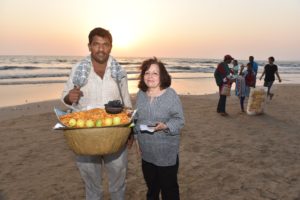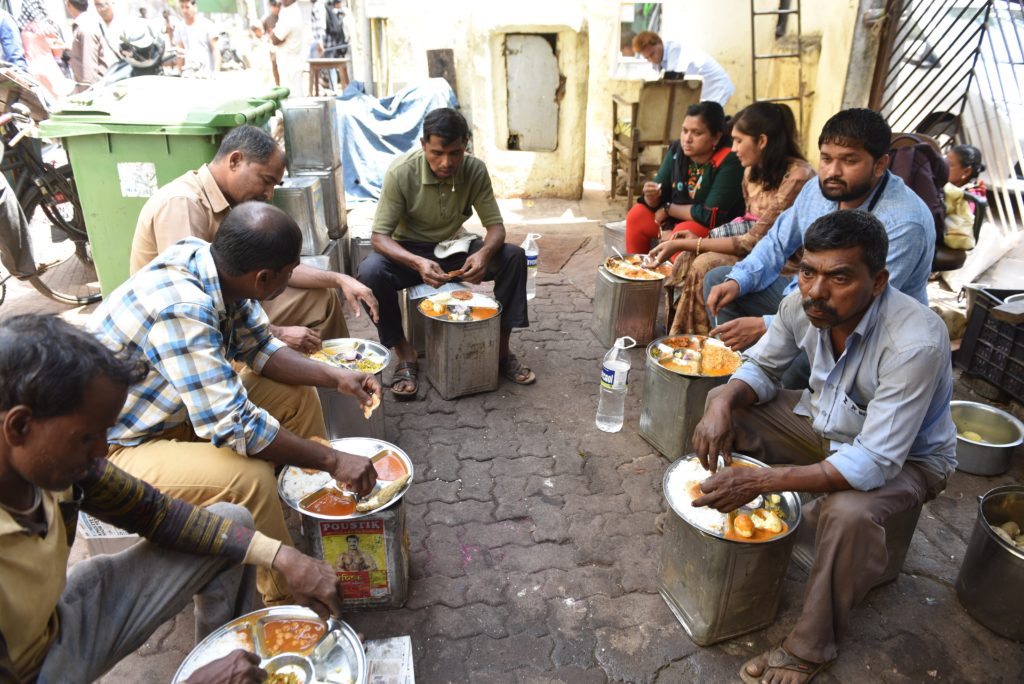6055 people reached on Lassi with Lavina FB page – 701 engagements. FB insights
826 Views on Linkedin – 10 Likes
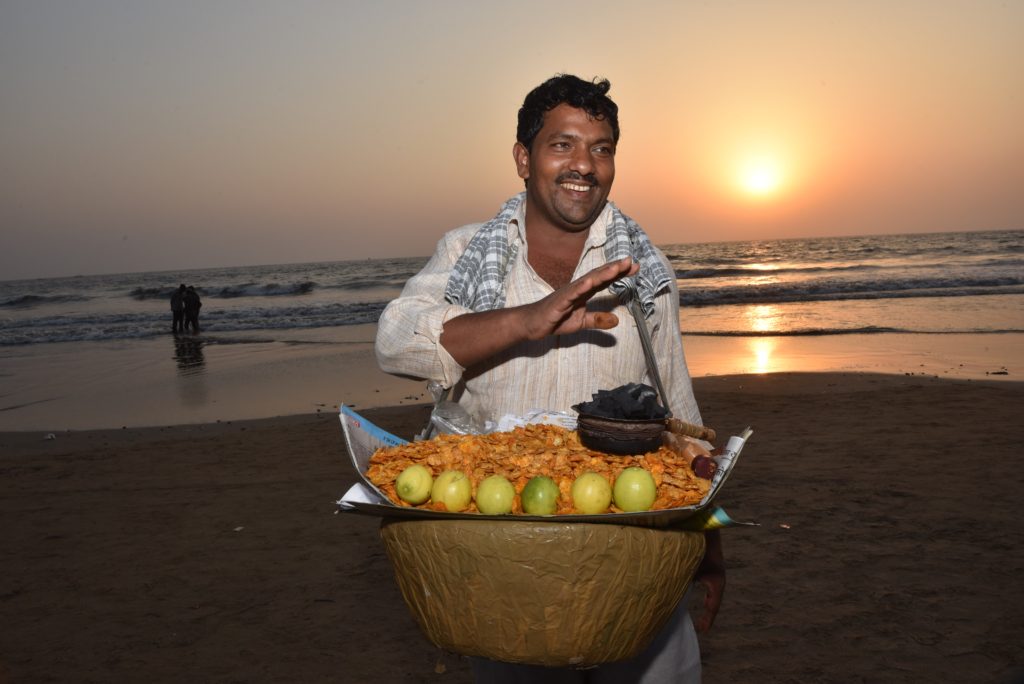
Remembering a pre-COVID foodie heaven
Mumbai – The City That Runs on Spice
The Street Foods of Mumbai – Vada Pav, Bhel Puri, Chaat Papri
As travel once again becomes a no-no with Omicron, Lassi with Lavina shares a past visit to Mumbai, spending glorious days eating the street food of the city. Till you can do it in person, enjoy this armchair trip- I already did all the eating for you! Vada Pao, Dosas, Bhel and everything else you can think of!
(Photos by Arun Mishra – courtesy: Hinduism Today)
[dropcap]][/dropcap]ndia runs on spice! A billion plus people can’t be wrong – they swear by the tangy, sour-sweet spicy street foods of India. And perhaps no city has more varied street foods than Mumbai which gets its name from Mumba or Maha-Amba – the goddess worshiped by Koli tribes who originally inhabited the island – and ‘Aai’ which means ‘mother’ in Marathi.
Indeed, there is something homey and comforting about the street foods of India, almost like the hug of a mother. Not surprisingly many of these street treats go back to ancient times and have been a part of Indian tradition and memory.
Dosas, Idlis and Vadas existed back in AD 1129
[dropcap]A[/dropcap]ccording to K.T. Achaya, author of ‘Indian Food – A Historical Companion’, many of the street foods of today can be traced back to AD 1129 when the Sanskrit work ‘Manasollasa’, attributed to King Someshwara, mentions so many of the delights: Purana was the puranpoli of today, sevika was the sev of the present day; dhosaka was the dosa of ancient times and idarika was idli. Even roasted vadas and bajjis (pakodas or fritters) are described in Tamil literature.
Chutney Pakodas and Bhondas
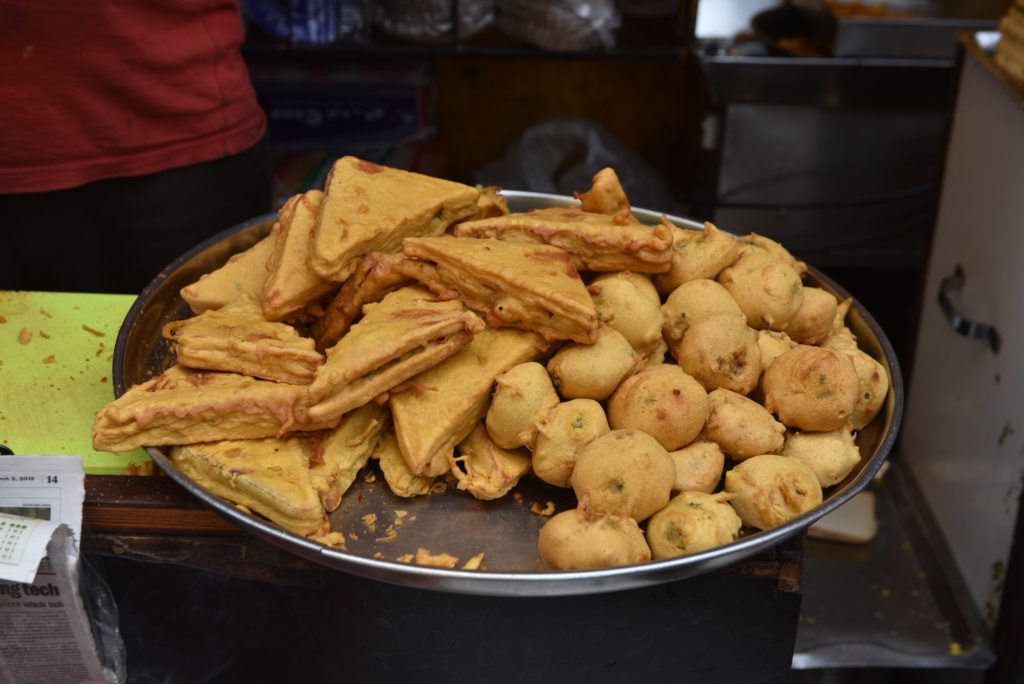
[dropcap]M[/dropcap]any ancient texts describe the snacks from which modern day street foods have evolved in various states from Bengal to Gujarat to Maharashtra. The Varanaka-Samuchaya of AD 1520 mentions so many of today’s Gujarati snacks such as deep fried rotlis, spiced parathas and vegetable stuffed puffs called gujiyas. Handva are appetizers which are baked in a handa. The snacks of Gujarat, known as Nasto and farsan are fried items which have been there from the 16th century, and are loved even today – sev, chevda and ganthia.These snacks have stood the test of time! Each city has some snacks which are common to all of India while there are others which are special to a state or city. Mumbai is one city which has welcomed dreamers and strugglers from every state so you find almost every regional snack on its streets.
The Vada Pav
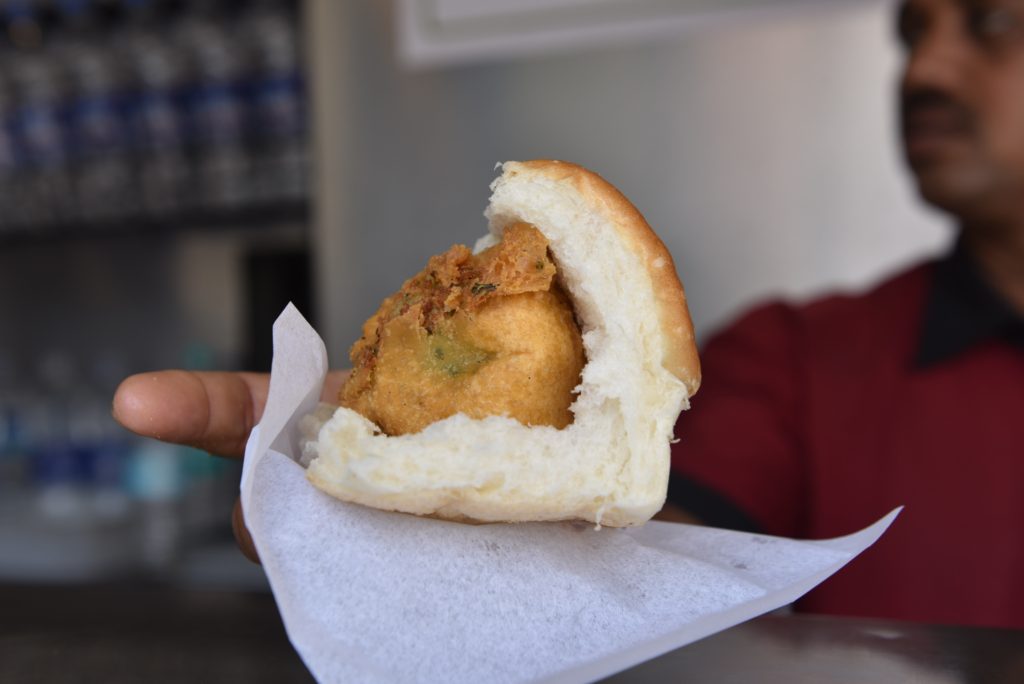
[dropcap]Y[/dropcap]ou can travel the world but you will still get the most delight from the foods of your childhood. For me, it’s the spicy crunchy bhel mix I used to eat near Churchgate Station, on the streets of South Bombay. The vendor had a makeshift stand and he would deftly add cubed potatoes, chopped onion and green chilies to the crunchy vermicelli of gram flour, toss around mysterious sauces and powders and serve the concoction in a newspaper cone. The spicy treat had us in tears, as we munched with sniffling noses and chants of ‘Make it hotter!’
Street Foods in the Back-Lanes of Childhood
[dropcap]T[/dropcap]hose halcyon days of streets food adventures came to mind, days when germs and Bombay belly were unknown to us and we would eat just about anything and survive. So now, decades later I was revisiting the back-lanes of childhood, to taste and embrace the lost joys of street food. Although I have been living in the west where we do get sanitized and gentrified versions of these delights in hotels and restaurants, often created by trained chefs, these ‘chaats’ are very much the soul food of ordinary people and and exist all over India – in villages, towns and cities – and the business of eating under the skies is alive and well.
The reality is that in India you will find the street foods wherever there is a street! Peanut and gram sellers on the Queen’s Necklace waterfront or at the Gateway of India as well as coconut sellers and pappad-wallahs carrying their crispy wafers in a basket balanced on their heads. These hasty tasty snacks are always light on the pocketbook and yet fill you up.
Pav Bhaji
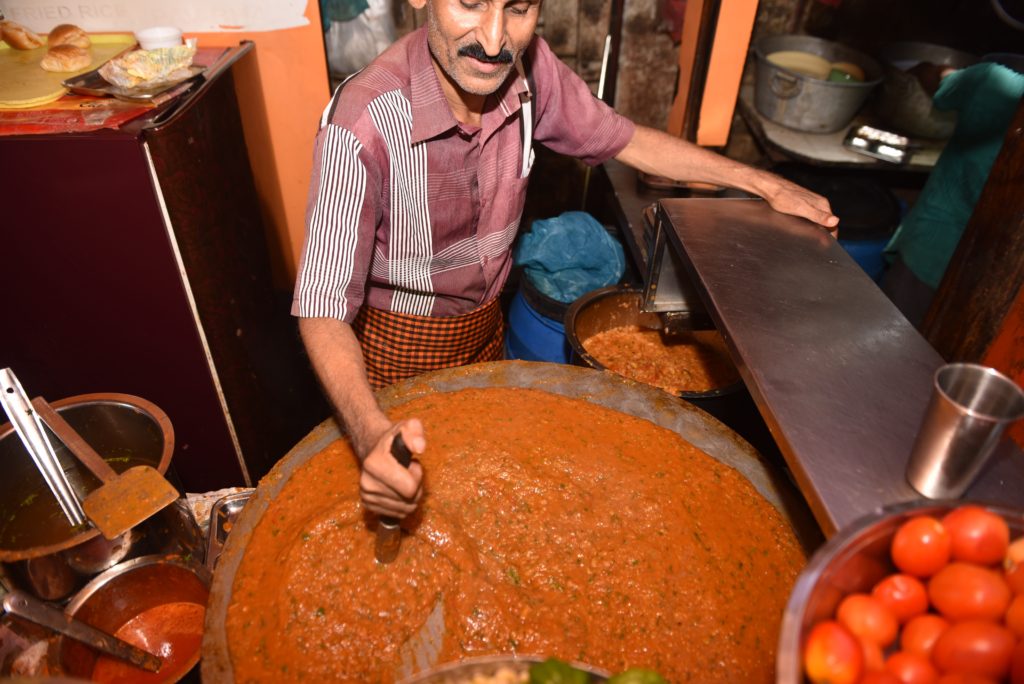
It is food you can carry with you as you run to catch a local train or a bus or a yellow taxi, or munch as you walk to wherever your feet can take you, on crowded streets and overhead pedestrian bridges below which churns chaotic tangled, traffic.
Mumbai, without a doubt, is the epicenter of Maharastrian snacks such as pav bhaji, vada pav, bhel puri, and ragda pattice. These are authentic Mumbai snacks and are found everywhere, in many of its 1500 restaurants but most deliciously in its roadside avatar as street foods, along with South Indian specials, Gujarati thali and chaats.
Vada Pav City
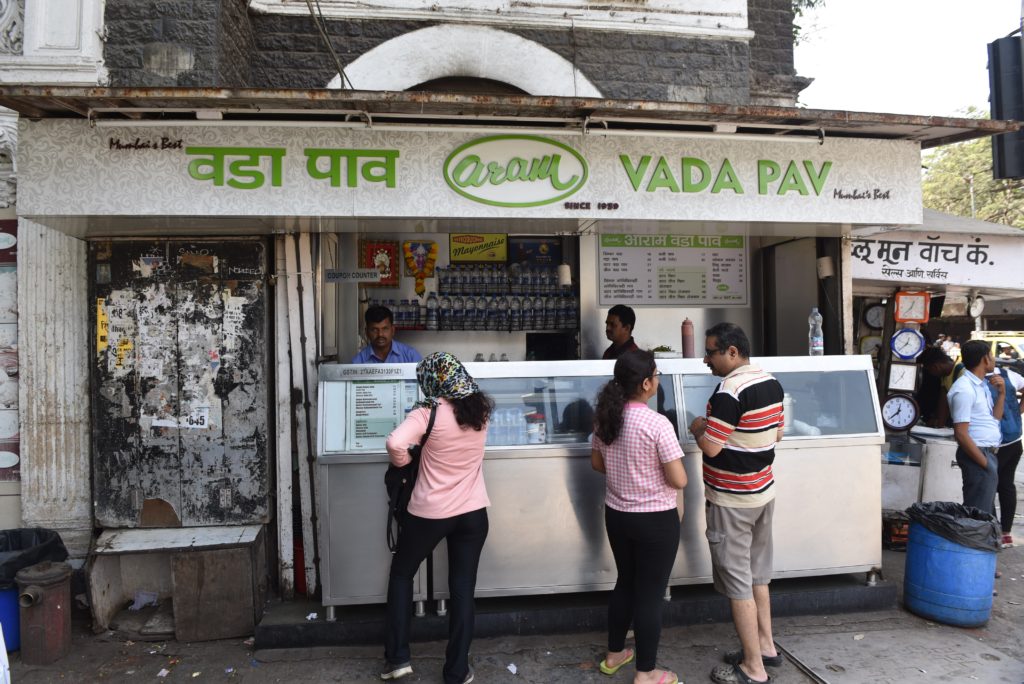
[dropcap]W[/dropcap]hile there are scores of vada pav-wallas all over Mumbai, I went to Aram Vada Pav – a famous store which the owner had started as a street vendor but he became so popular with a mass following (before the days of social media!) that he started his own shop where even today crowds gather to get a taste of his treat.
In Colaba, in Pasta Lane, you have Kailash Parbat, the old eatery which is now gentrified but which offers the spicy gol-guppas, pani puris and chaat papri which are the must-haves. It also offers mithais and specializes in Sindhi sweets. Around Holi, they bring out geyar, a flat, bigger version of the syrupy orange jalebis.
Lunch in Khau Galli
street-foods – Khau Gully
Dining in the streets
Have You Visited the Khau Gallis or Eating Streets?
[dropcap]M[/dropcap]umbai is also famous for its Khau Gallies or ‘eating streets’ where you can get a cornucopia of regional treats. Close to the Churchgate Railway Station is one such street – a wondrous warren of small shacks which offer street foods to the locals, working people and students. There is such a vast variety that you can get completely overwhelmed! Space is also at a premium – you either stand and eat or create a spot for yourself. I saw some hungry diners sitting on top of old aluminum containers, using other containers as tables.
Street Food Explorers at the Churchgate Khau Galli
Lenin Pav Bhaji Center and More
The Khau Galli is mind-boggling in the variety with scores of makeshift stalls right next to each other. There’s even a Lenin Pao Bhaji stall! It’s the owner’s real name – he’s from Kerala and the bustling stall not only sells pure veg pav bhajji by the gallon but also make pure veg Chinese fried rice and noodles! I love the enterprise and creative thinking of these street vendors! By catering to varied tastes, they have a captive audience of laborers, office workers and students.
Lenin, Pav Bhaji and Veg Fried Rice
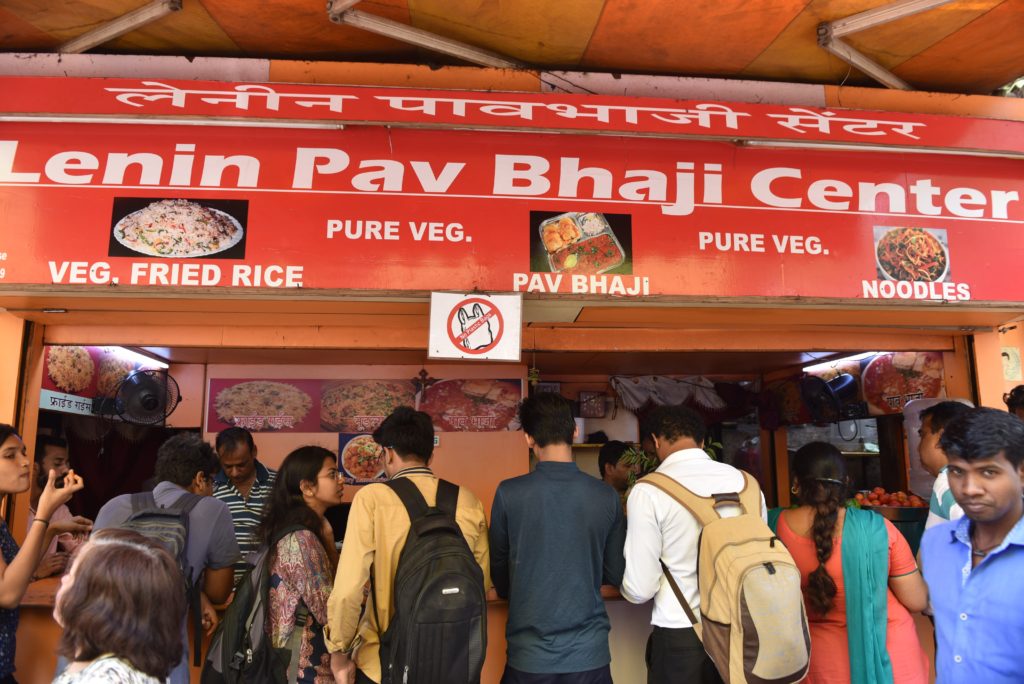
Fruit Chaat and Milkshakes for Fasters
[dropcap]S[/dropcap]treet-eaters actually eat quite healthy food too because other popular street foods are roasted corn on the cob, pineapple and watermelon chunks, as well as fruit chaat. These are all served fresh with a generous squeeze of lemon juice and some chaat masala which really spices up the tastebuds. The fruit chaat is often cubed cucumbers, potatoes, bananas and guava – these humble fruits and vegetables get their tangy flavor from the secret masalas the vendor sprinkles them with and turns them into a gourmet delicacy.Another street vendor was selling special drinks for Upvas or fasts – only in India! These are milk shakes with almonds, figs and other fruits acceptable for those fasting. You can have them on the street for Rs. 20 or you can place an order with these ambitious and hopeful entrepreneurs for weddings and parties! In the streets with street food – anything is possible, like the plot of a Bollywood movie!
Fruit Chaat in the Streets
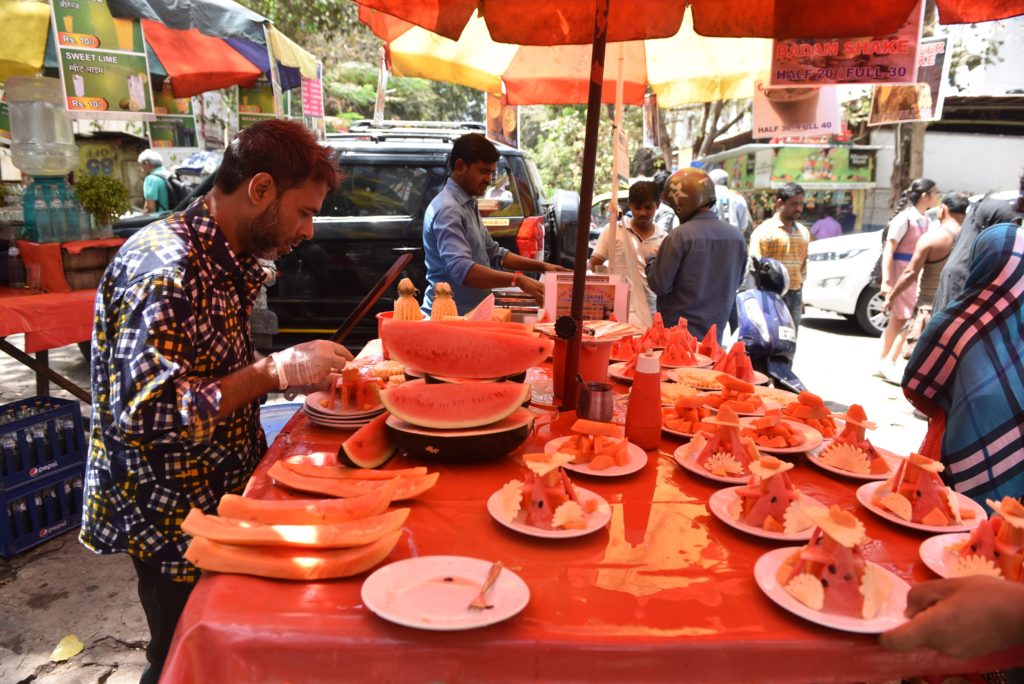
Gopal Papadwalla, Chef of the Streets
[dropcap]A [/dropcap]bustling Khau Galli also exists in Zaveri Bazaar which is a crowded jewelry district with countless gold wholesalers, ramshackle buildings and nonstop traffic. We tried a papad treat from Gopal Papadwalla, a young street vendor who has quite a menu and kept producing different ingredients from his magic cart, using the papad almost like a pizza shell. He left his village to ply the trade of his forefathers in the big city and his cart is decorated with Gods and glamorous Bollywood stars and the menu reads butter masala, cheese masala and fruit masala.
Close by was a stall where you could get spicy chole from huge vats and puris, fried ballooning breads. Hungry working class crowds waited for this basic treat at lunchtime. Food is everywhere you look.
Meet Gopal Papadwalla
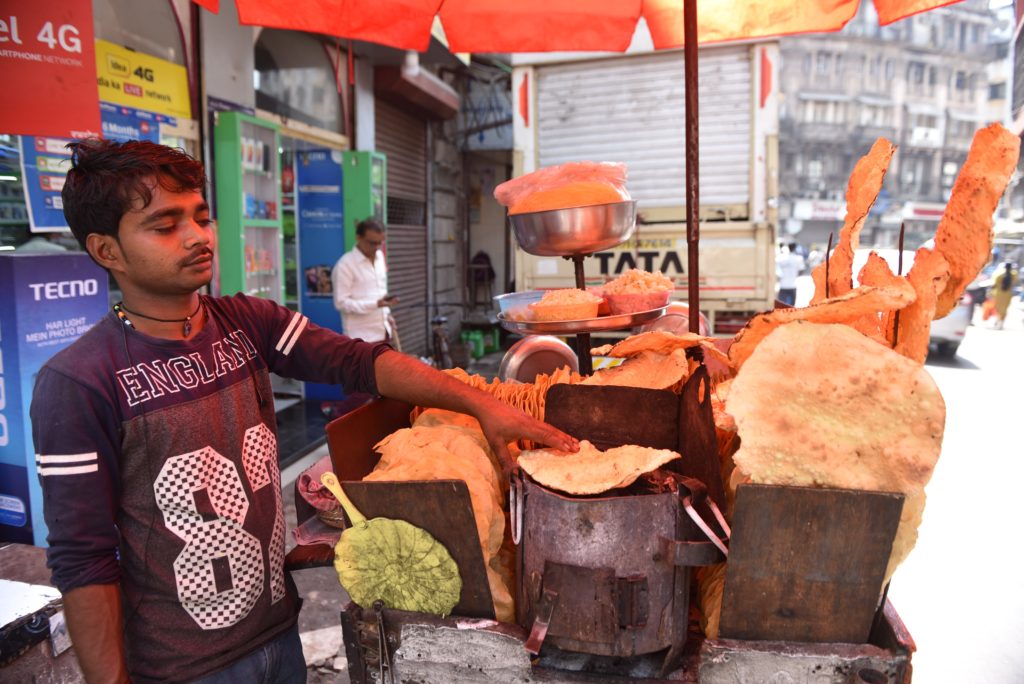
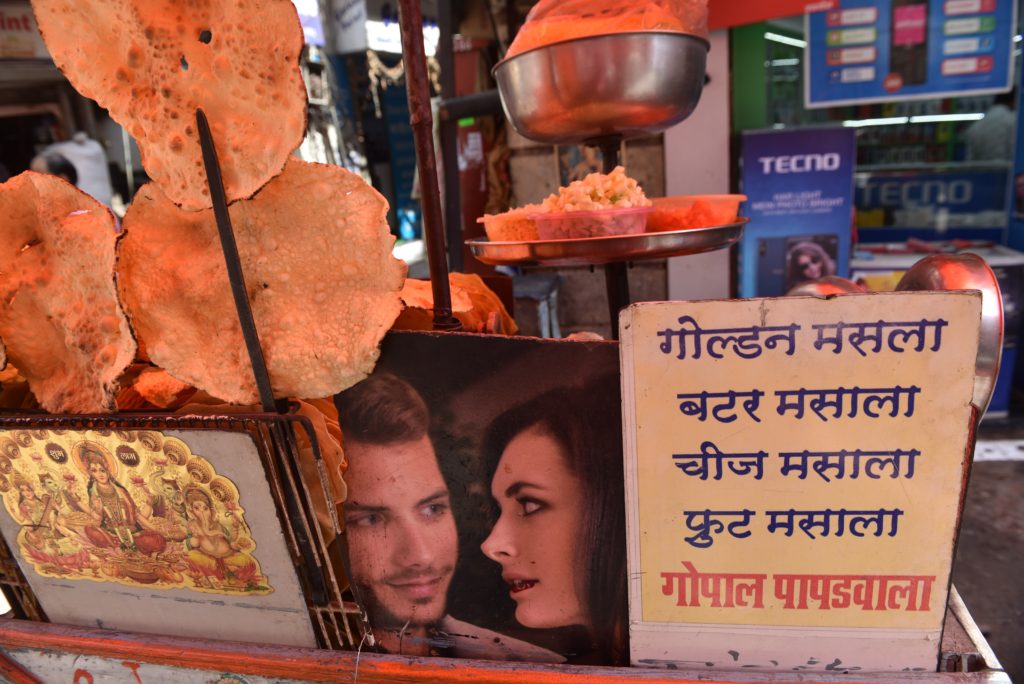
Chutney Pakodas and Shoe Repair
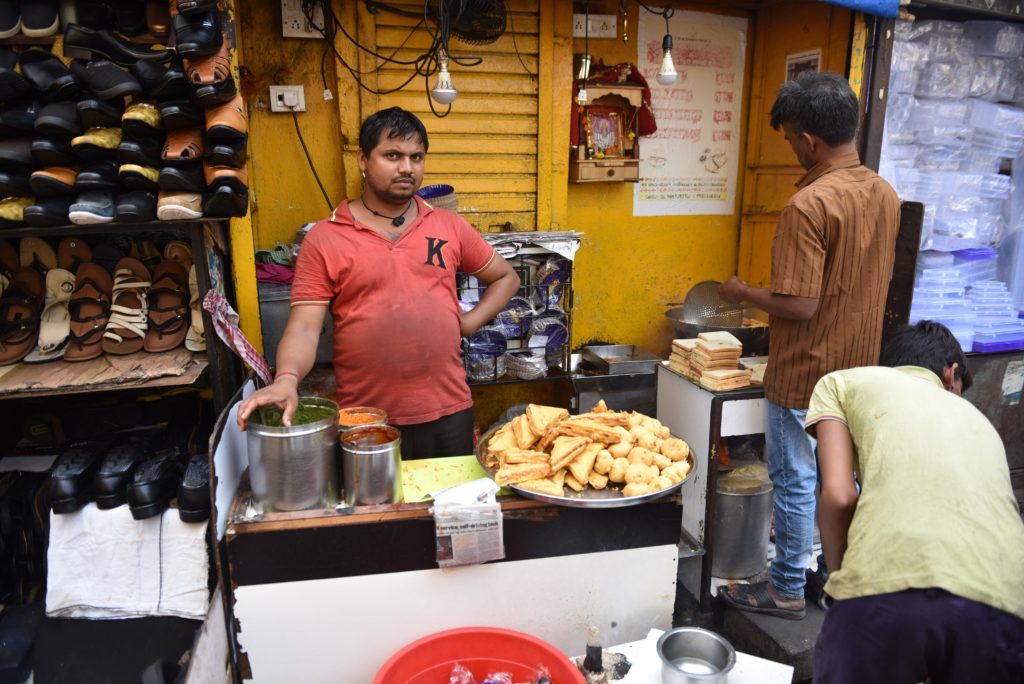
[dropcap]W[/dropcap]alking down the twisted lanes, I came across another vendor selling hot green chutney pakodas, a treat I used to relish in my college days. This stall was disconcertingly right next to a stand selling footwear, and seemed to have a buzz of flies which are just about everywhere in the Mumbai heat. The pakoda salesman had an assistant who was splattering green chutney on the slices of bread and then these sandwiches were dipped in a besan or gram flour batter and deep fried in a karahi of hot oil, right on the street. The result – crunchy, crispy golden chutney pakodas.
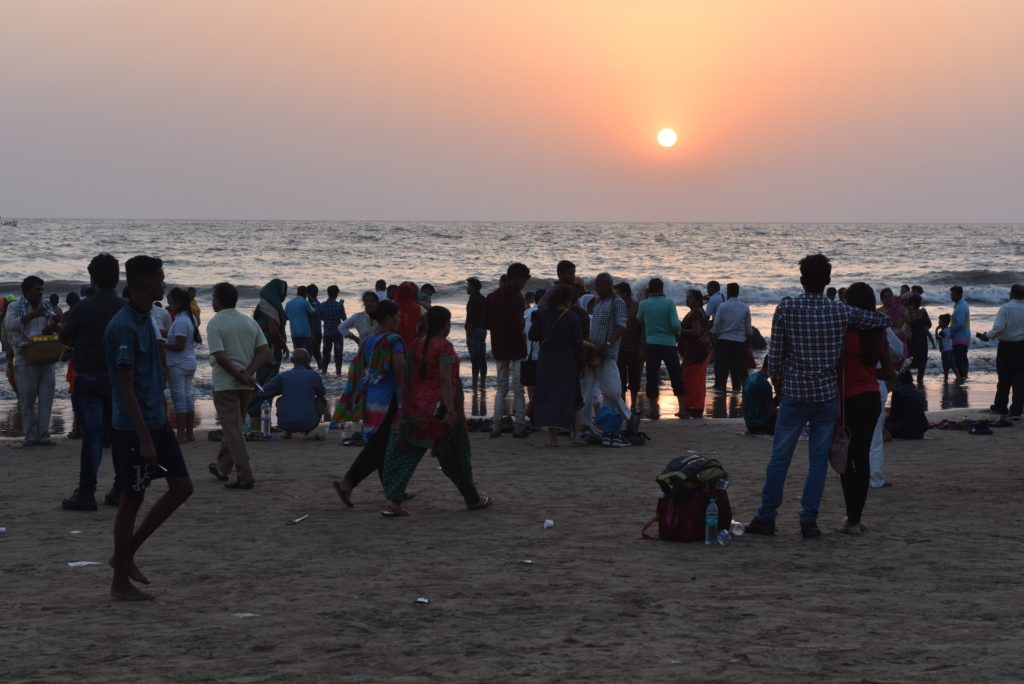
Street Foods on the Beach in Mumbai
[dropcap]M[/dropcap]umbai’s beaches are not used for swimming or sunbathing as in other countries – but for family outings and strolls along the water’s edge as the waves hit against the shore. The two well-known beaches are Chowpatty and Juhu, and they are both wonderlands of street food.
My childhood memories of Chowpatty are blurred but I do have a black-and-white faded photo which shows me as a five-year-old, sitting with my family on a bench, as they dig into plates of chaat. Chowpatty, with neon lights decorating the little seaside shacks, has still a fairyland look and I am sure children today love the experience as I did. Be it vada pav, bhel, pista or chiku kulfi – everything is available and just for a few rupees.
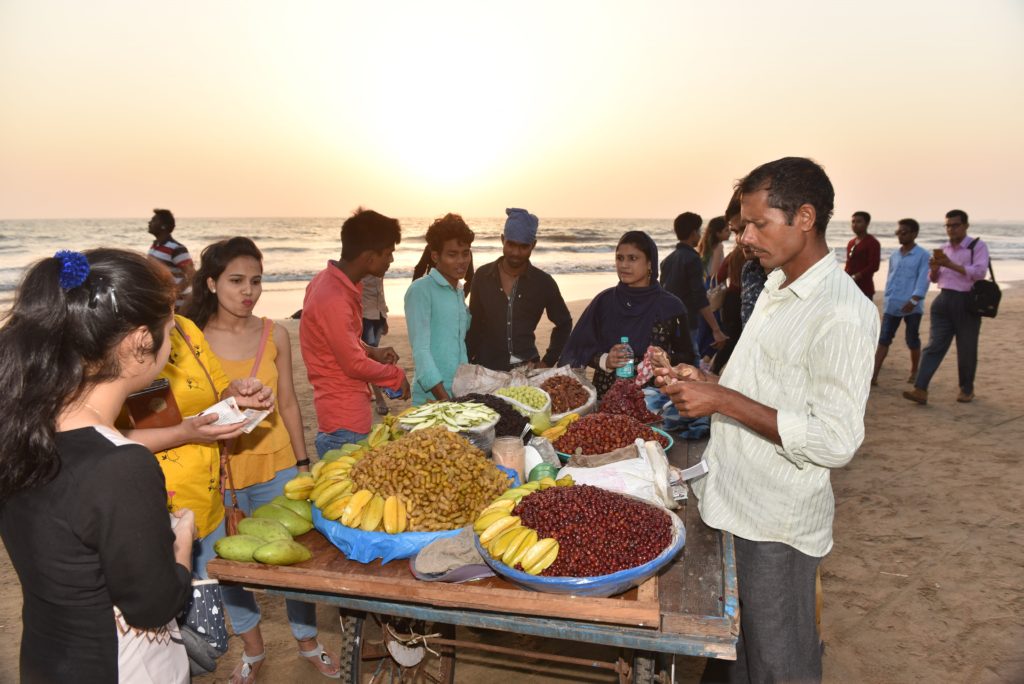
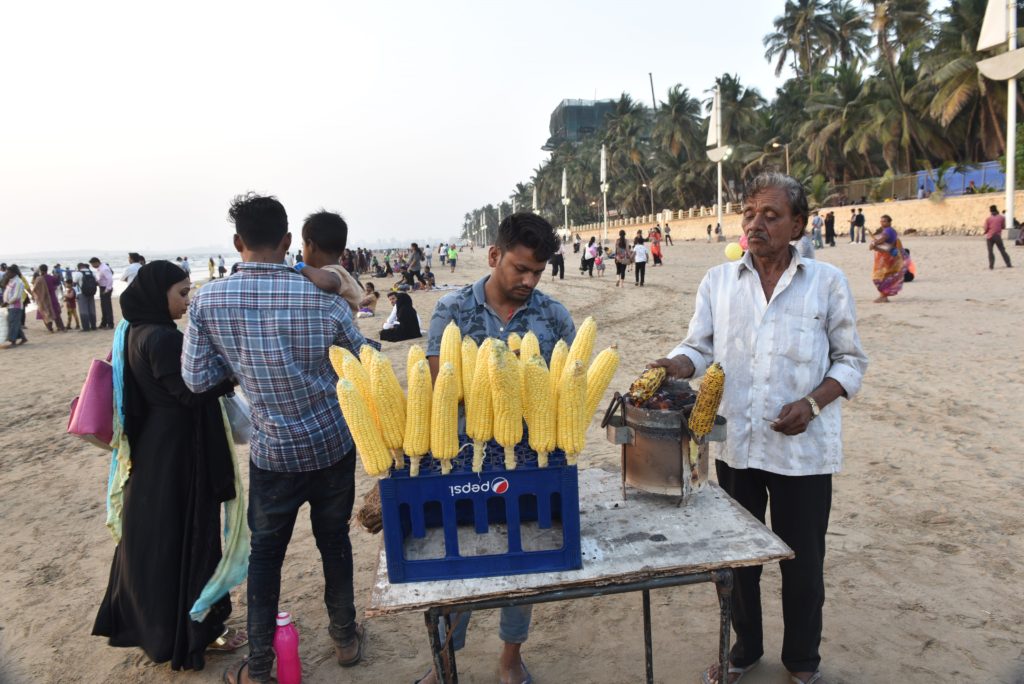
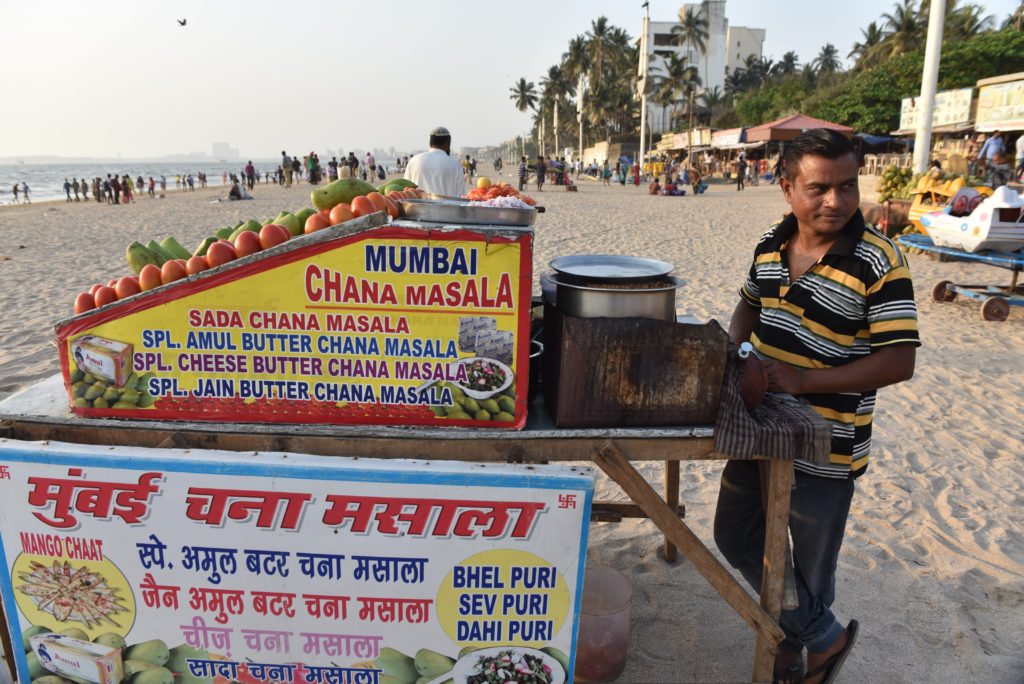
Amul Cheese in Mumbai Chana Masala?
[dropcap]I[/dropcap] also journeyed to Juhu Beach and here the scenario had changed. While there were street food vendors on the sands, they were a handful amongst the many strollers and frolicking families on the beach. I was intrigued to find Amul cheese was an ingredient in this seaside street food. There was a sada or plain variety, a special one with Amul butter and another special with both butter and cheese. There was also a Jain variety, probably without onions!
The majority of the vendors were now housed in a covered building on the beach – and here you had small stalls of every street food imaginable – sizzling tikis (potato turnovers), dosas, vadas and chaat of every variety. The vendors all had hair-coverings and gloves, and even masks. Certainly it was all more organized and sanitized but to some extent, the earlier scruffiness and randomness had its own charm. However, the bustling crowds seemed to love this modern setup and since the vendors were mostly the same, this new urbanization was definitely an improvement in their lives and business.
Street Foods Move Indoors
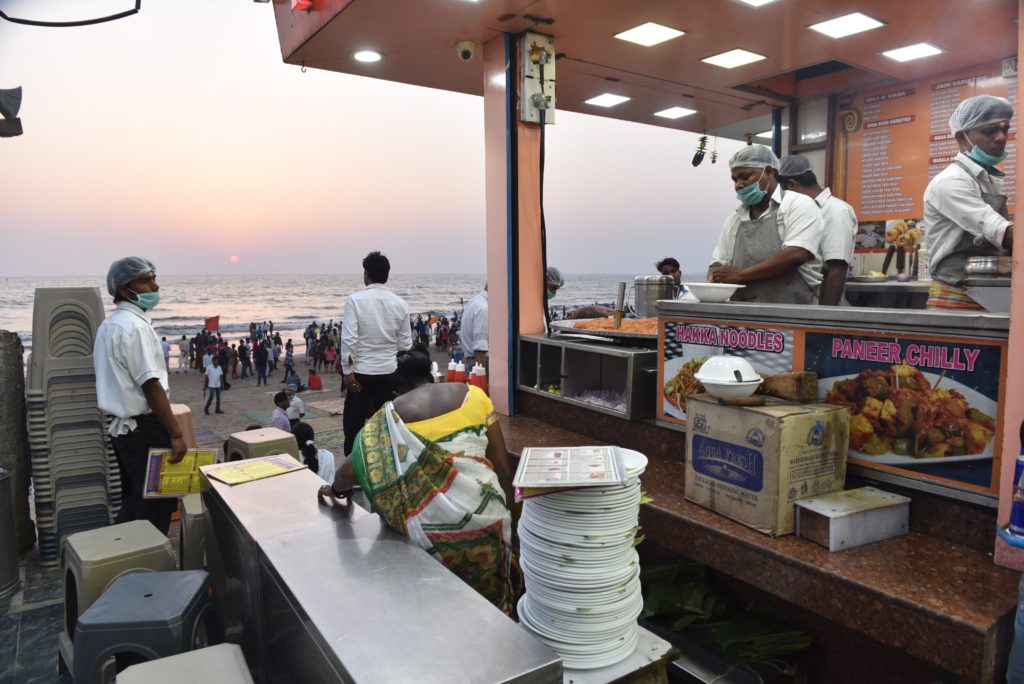
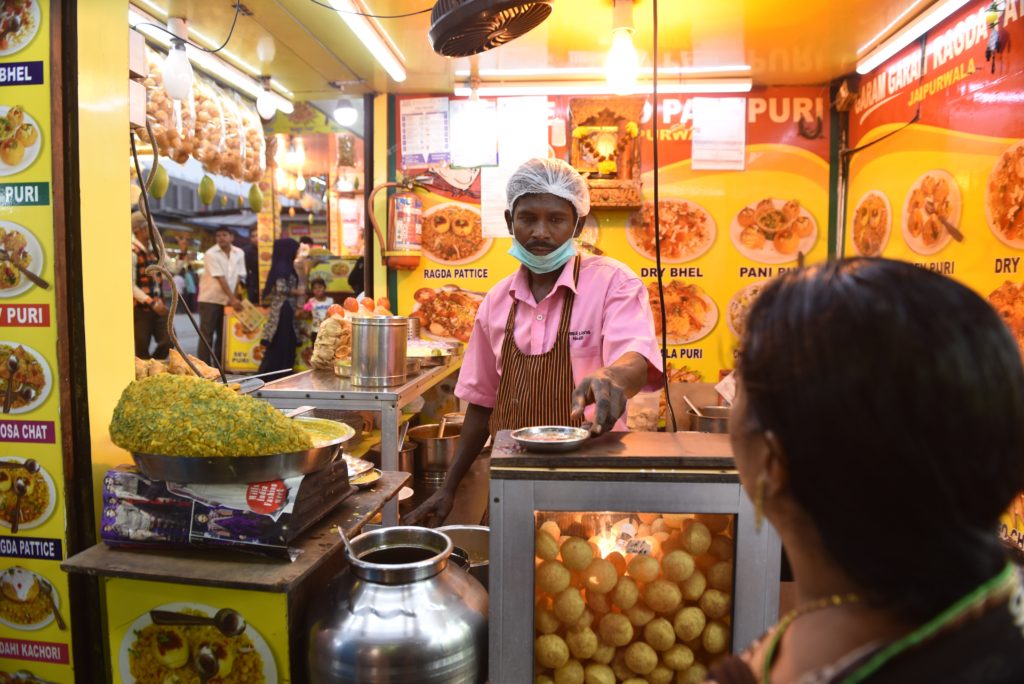
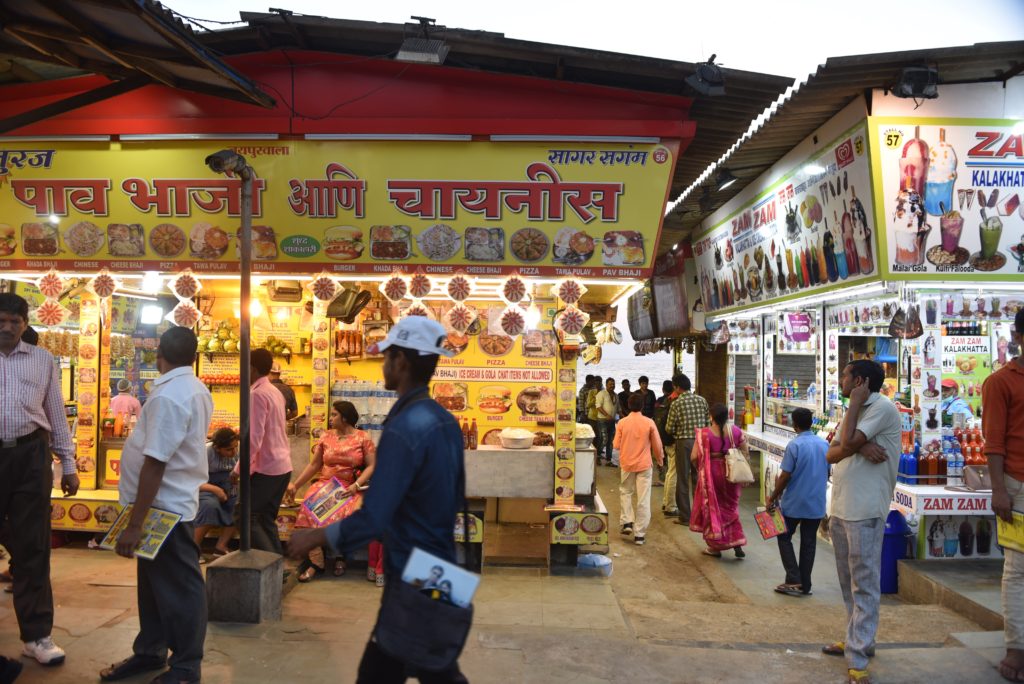
Final Stop – the Bollywood Celebrity Paanwalla in Juhu
[dropcap]A[/dropcap]s the golden sun was setting over the Arabian Sea, turning the sky into a flaming orange, we left the expanse of the beach for the chaos of the crowded streets of Bandra. Arun, our photographer who is a Mumbai native, showed us where everyone goes to end a day of street food binging – a paan-wallah’s stand – Mishra’s Paan Bhandar.
Paan is a rolled up betel leaf stuffed with condiments and is a mouth freshener and sweet ending to any feasting in India. Since Juhu Beach is in the suburb of Bandra where many of the Bollywood stars live, some of these celebrities drive by in their limousines to stop by for a fresh paan. The paan store is a small hole in the wall but noted celebrities like Amitabh Bachchan have stopped by to get one of the famous juicy paans which are dipped in edible silver foil. That is the ultimate in street food so I just had to have one! The young owner who was carrying on his father’s legacy whipped up a special paan for me and shared some succulent Bollywood tales too.
As I ended my street food journey, I realized that the past doesn’t really vanish – it just realigns itself as memories and mixes in the present. I was happy to revisit childhood and see that the vibrancy of street food is still there, creating memories for a whole new generation. You don’t need a fortune to be happy – just a spicy plate of papri chaat or bhel puri will do the trick!
(A version of this article was first published in Hinduism Today – all photos courtesy of Hinduism Today. Photo credit – Arun Mishra )
